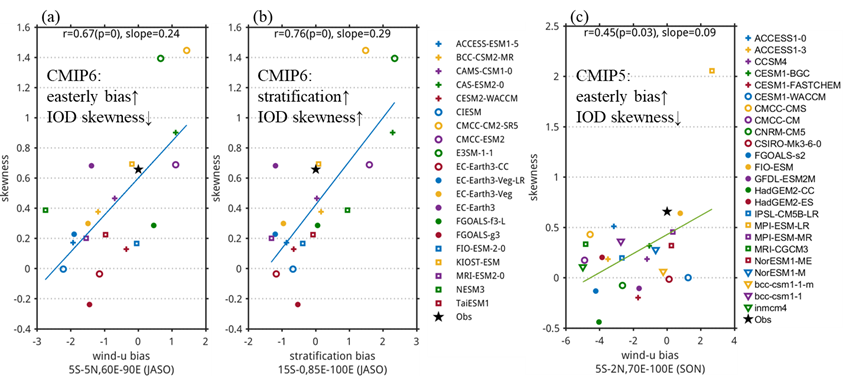
Education:
Ph.D. candidate in Atmospheric Science, The Chinese University of Hong Kong, 2021-2024
Master of Physical Oceanography, South China Sea Institute of Oceanology, 2018-2021
Bachelor of Marine Science, Ocean University of China, 2014 – 2018
Yi-ling ZHENG
Research Interests:
- Climate Dynamics
- Large-scale ocean-atmosphere interactions
- Climate change
Recent Research Projects:
The Indian Ocean Dipole (IOD) is the dominant mode of interannual variability in the tropical Indian Ocean, characterized by surface cooling (warming) of the eastern Indian Ocean in its positive (negative) phase. Observed IOD events exhibit distinct amplitude asymmetry in relation to negative nonlinear dynamic heating (NDH) and asymmetric thermal damping. NDH is associated with the asymmetric nonlinear temperature advection and sea surface temperature (SST) response to thermocline changes. The thermal damping is caused by the cloud-radiation-SST feedback, which develops minor additional damping after cold SST anomaly leading to a cloud-free condition. In CMIP5, nearly all models simulate less-skewed IOD compared to the observed. On the other hand, for CMIP6, 6 out of 20 models show realistic skewness. Further examination reveals that the improvement of IOD skewness in CMIP6 over CMIP5 can be attributed to the former’s improved model mean states, particularly the western tropical Indian Ocean (WTIO) SST. Analyses of “less skewed models” indicate that when background SST in WTIO exceeds the SST for maximum precipitation sensitivity, the convective response to SST becomes asymmetric, leading to less zonal wind response and weaker zonal nonlinear advection during positive IOD. The warm SST bias in turn is associated with the weaker Indian summer monsoon. Additionally, ocean stratification also influences the IOD skewness: stronger stratification can lead to larger nonlinear SST response to thermocline changes; this is due to larger vertical temperature gradient resulting in larger nonlinear vertical advection. Our findings imply that substantial efforts should be made in reducing the Indian summer monsoon bias as well as advancing the upper-ocean stratification in the eastern Indian Ocean, for properly representing IOD in Earth System Models.

Figure 1. (a) Mean zonal wind bias versus IOD skewness in CMIP6. (b) Mean stratification bias versus IOD skewness in CMIP6. (c) Mean zonal wind bias versus IOD skewness in CMIP5.
Publications:
- Zheng, Y.-L., C.-Y. F. Tam, and M. Collins, 2024: Reduced Indian Ocean Dipole Asymmetry and Increased Extreme Negative Events under Future Greenhouse Warming, J. Climate, https://doi.org/10.1175/JCLI-D-24-0107.1
- Zheng, Y.-L., C.-Y. F. Tam, X. Kang and M. Collins, 2023: Origins of Underestimated Indian Ocean Dipole Skewness in CMIP5/6 Models, J. Clim., https://doi.org/10.1175/JCLI-D-23-0412.1
- Zheng, Y.-L., Y. Du, J.-W. Chi, S.-P. Xie, 2021: Rapid changes in northeastern tropical Pacific Ocean surface salinity due to trans-basin moisture transport in recent decades. Climate Dynamics, 56, 2245–2257. https://doi.org/10.1007/s00382-020-05585-9
